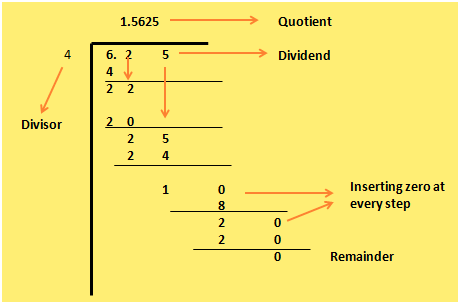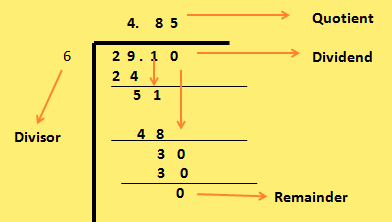Division of a Decimal by a Whole Number
This topic would discuss about division of decimal by a whole number. As in multiplication of decimal number we have done the multiplication ignoring the decimal point same as that in division also we will do the division ignoring the decimal point and when we reach the tenths place that is first place in the fractional part of the decimal number we will place the decimal point.
Steps of division of a decimal by a whole number:
Step I: First divide the decimal by the whole number ignoring the decimal point
Step II: Then on reaching the tenths place that is the first place in the fractional part of the whole number place the decimal point
There is another trick in division of a decimal is that then the digits in the dividend is no more but the division is not complete then we need to add zeros at each step till the division is complete.
Here are few examples to illustrated division of decimal by a whole number:
1. 6.25 ÷ 4
Solution:
Explanation:
Here 6.25 is divided by 4 (ignoring the decimal point) and the remainder is 1. Now put the decimal point in the quotient after division of 6 by 4 that is after 1 in the quotient the decimal point is placed. But in decimal division we cannot leave any remainder at the end and the rule is that at each step (after there are no more digits in dividend) one zero is added. Hence with the remainder 1 a zero is added to make it 10 Now 4 multiplied by 2 is 8 again a remainder 2 hence another is zero placed with 2 making it 20. Now 4 multiplied by 5 is 20 with no remainder.
2. 8.25 ÷ 2
Solution:
Here in this sum we have to divide 8.25 by 2 (ignoring the decimal point) and the remainder is 1. Place the decimal point in the quotient after dividing 8 by 2 that is 4. Now we can see that on dividing 8.25 by 2 we get a remainder 1 but we cannot leave remainder in case of division of decimal. So, a zero is placed with the remainder 1 to make it 10. Then 2 multiplied by 5 is 10.
3. Divide 29.10 by 6
Explanation:
Here 29.10 is divided by 6 ignoring the decimal point. Then in the quotient the decimal is placed after dividing 29 by 4 that is after the first digit. On dividing 29.10 by 6 there is no remainder hence we need not put any extra zero at any step to complete the division.
4. Divide 2.356 by 5
Explanation:
Here 2 cannot be dividend by 5 as 2 is less than 5 hence we need to consider 23. As 2 cannot be divided by 5 hence we need to put 0 in the quotient and then place the decimal point and continue the division. At the last step we would get a remainder 1 and in decimal division we know we cannot leave remainder hence a zero is placed with 1 to make it 10. Then 5 multiplied by 2 is zero.
From Division of a Decimal by a Whole Number to HOME PAGE
Recent Articles
-
Eleventh Grade | Eleventh Grade Science | Eleventh Grade Math
Jun 27, 25 12:26 AM
Eleventh grade biology has been designed in accordance with the recommended topics. We will cover all the topics in biology very exciting and interesting way. -
Explain Digestion of Food | Salivary Glands | Oesophagus | Stomach
Jun 27, 25 12:20 AM
Before the digestion is start by the different enzymes secreted from the different digestive glands food must be turned and chut or mixed with saliva inside the mouth. -
Explain Human Digestive System | Mouth | Tongue | Pharynx | Teeth
Jun 21, 25 01:15 PM
Digestive system is a system of alimentary canal and digestive glands. Alimentary canal- alimentary canal is a tube of variable diameter having muscular wall and glandular epithelial tissues which sta… -
Vernalisation in Plants | Definition | Mechanism | Devernalization |
Jun 18, 25 01:34 PM
Definition of vernalisation- The change of flowering habit due to the low temperature treatment is known as vernalisation. This is a physiological process which was denoted by Clipart in 1857 invite b… -
The Food We Eat | Food we Get from Plants and Animals | Carbohydrates
Jun 15, 25 03:20 PM
What are the food that we should eat? Find out the names of ten food items in the word maze. Write the names in the correct column of the table given below. Food we get from plants Food we get from an…









New! Comments
Have your say about what you just read! Leave me a comment in the box below.